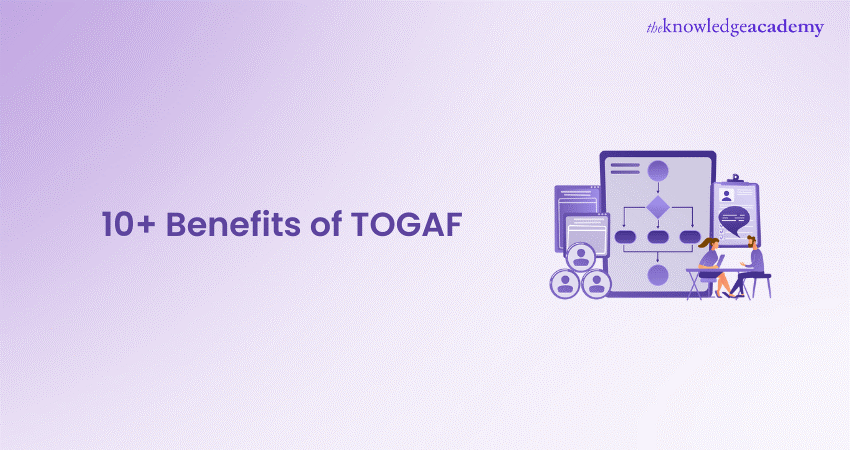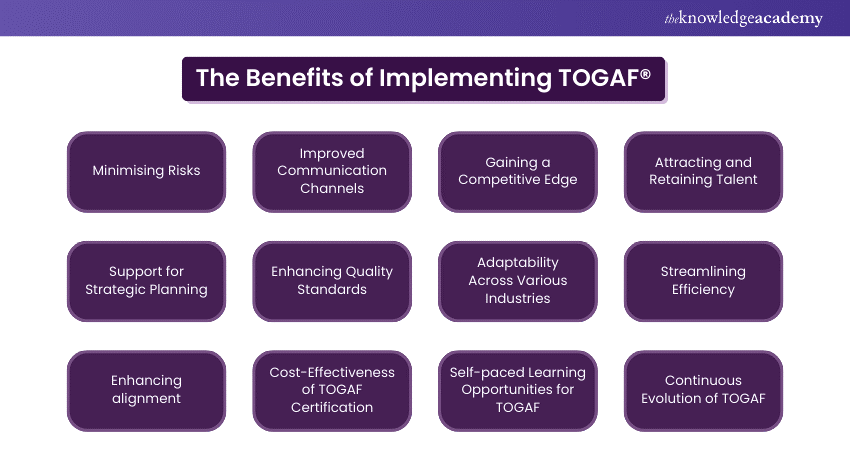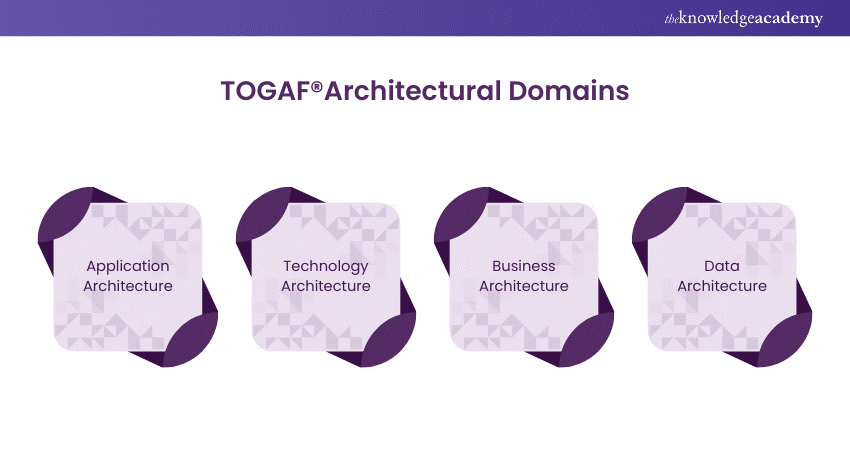We may not have the course you’re looking for. If you enquire or give us a call on +918037244591 and speak to our training experts, we may still be able to help with your training requirements.
We ensure quality, budget-alignment, and timely delivery by our expert instructors.

TOGAF is a globally recognised Enterprise Architecture Methodology that functions much like a blueprint for building a house. Just as a blueprint provides a clear and structured plan to ensure every component of a house is correctly placed and built, TOGAF offers a comprehensive approach for designing, planning, implementing, and governing enterprise information architecture. The Benefits of TOGAF are numerous, ranging from improved risk management to enhanced communication channels, making it an indispensable tool for organisations aiming for efficiency and strategic alignment. This blog explores the multitude of benefits TOGAF brings to an organisation.
Table of Contents
1) What is TOGAF®?
2) The Benefits of Implementing TOGAF®?
a) Minimising Risks
b) Improved Communication Channels
c) Gaining a Competitive Edge
3) Roles of TOGAF® in Diverse Architectural Domains
a) Application Architecture
b) Technology Architecture
c) Business Architecture
4) Conclusion
What is TOGAF®?
TOGAF is a framework used to develop and manage an Enterprise Architecture. It is widely adopted by organisations. TOGAF enhances business efficiency. It includes a detailed methodology. TOGAF also provides a set of tools for developing Enterprise Architecture. This ensures alignment between an organisation's business goals and IT strategy.
The Benefits of Implementing TOGAF®
Implementing TOGAF can bring significant advantages to organisations. Here are the top 12 benefits explained in detail:

1) Minimising Risks
a) Identifying and Mitigating Risks:
TOGAF helps in identifying potential risks early in the project lifecycle. It provides structured approach. This enables organisations to mitigate risks related to technology. It also aids in addressing risks tied to processes and people.
b) Ensuring Compliance:
It ensures that all aspects of Enterprise Architecture comply with industry standards. This reduces the likelihood of compliance issues.
2) Improved Communication Channels
a) Unified Vocabulary:
TOGAF promotes the use of common language across the organisation. This helps in reducing misunderstandings. It also improves clarity among stakeholders.
b) Facilitating Collaboration:
By fostering better communication TOGAF enables different departments to work together more effectively. This ensures everyone is on the same page.
3) Gaining a Competitive Edge
a) Strategic Alignment:
TOGAF ensures that IT initiatives are aligned with business objectives. This leads to improved strategic decision-making. It also results in a stronger competitive position in the market.
b) Innovative Solutions:
The framework encourages innovation. It enables organisations to adapt to new technologies and market trends swiftly.
4) Attracting and Retaining Talent
a) Professional Development:
Implementing TOGAF provides employees with opportunities for professional growth. It fosters their development. This makes the organisation an attractive place to work.
b) Skill Enhancement:
Employees certified in TOGAF possess valuable skills. These skills enhance their ability to contribute to the organisation’s success, leading to higher job satisfaction and retention rates.
5) Support for Strategic Planning
a) Long-term Vision:
TOGAF aids in the development of a clear long-term vision for the organisation’s IT infrastructure. It ensures that it supports business goals over time.
b) Informed Decision-making:
It provides a structured approach to strategic planning. This enables informed decision-making. It also aids in efficient resource allocation.
6) Enhancing Quality Standards
a) Consistent Processes:
TOGAF promotes the use of standardised processes. These best practices enhance the quality. They ensure the consistency of the organisation’s outputs.
b) Continuous Improvement:
The framework supports continuous improvement. It does this by regularly reviewing the architecture. Updates are made to meet evolving business needs. Additionally, industry standards are considered.
Give a kickstart to your career by gaining TOGAF certification – Register for our TOGAF® 9 Training Course: Foundation (level 2) now!
7) Adaptability Across Various Industries
a) Versatile Framework:
TOGAF’s flexible methodology can be adapted to suit the specific needs of different industries. It makes it a valuable tool for a wide range of organisations.
b) Cross-industry Application:
Whether in finance, healthcare, manufacturing or technology, TOGAF provides a robust framework. It supports diverse business environments.
8) Streamlining Efficiency
a) Optimised Processes:
By providing a clear methodology, TOGAF helps organisations streamline their processes. This leads to increased efficiency and productivity.
b) Resource Utilisation:
It ensures the optimal utilisation of resources by aligning IT initiatives with business priorities. This results in the reduction of waste and redundancies.
9) Enhancing Alignment
a) Business-IT Alignment:
TOGAF ensures that the organisation’s IT infrastructure is closely aligned with its business strategies. This alignment enhances overall efficiency. It also improves effectiveness.
b) Goal Congruence:
The framework fosters a cohesive approach where all parts of the organisation work towards common goals.
10) Cost-Effectiveness of TOGAF Certification
a) Affordable Certification:
TOGAF certification is relatively affordable compared to other industry certifications. This affordability makes it accessible for wide range professionals.
b) Return on Investment:
The skills and knowledge gained through TOGAF certification lead to significant improvements in organisational efficiency. This provides a high return on investment.
Learn how TOGAF and ITIL complement each other to optimize your IT strategy.
11) Self-paced Learning Opportunities for TOGAF
a) Flexible Learning:
TOGAF certification programs offer self-paced learning options. They allow professionals to study at their own convenience. This flexibility helps them maintain their work schedules.
b) Accessible Resources:
Numerous online resources and training materials are available for TOGAF. These materials make it easy for individuals. They can prepare for certification.
12) Continuous Evolution of TOGAF
a) Regular Updates:
TOGAF is continuously evolving. It includes regular updates and enhancements. These reflect the latest industry trends and technological advancements.
b) Adaptability:
This continuous evolution ensures that TOGAF remains relevant and adaptable. It addresses changing needs of organisations. It also responds to the broader market environment.
Sign up for the TOGAF® Foundation and Practitioner - Foundation Course accredited by The Open Group to boost your career in Enterprise Architecture!
Roles of TOGAF® in Diverse Architectural Domains
TOGAF supports the development and management of Enterprise Architecture in four primary domains: Application Architecture. Technology Architecture. Business Architecture and Data Architecture. Each domain plays a crucial role in achieving business objectives. They also drive organisational efficiency.

1) Application Architecture
Definition: Application Architecture defines the major kinds of application systems necessary to process data. It supports the business functions of the enterprise.
Roles and Benefits:
a) Standardisation: Provides a standardised method to design and develop applications. Ensures compatibility and interoperability.
b) Scalability: Helps in creating scalable applications. These applications can grow with the business.
c) Integration: Facilitates seamless integration of various applications. This enhances overall system efficiency.
d) Cost Efficiency: Reduces redundancy. Improves resource utilisation, leading to cost savings.
e) Flexibility: Enhances the ability to adapt to new technologies and business processes.
2) Technology Architecture
Definition: Technology Architecture outlines hardware and software infrastructure required to support the deployment of business data. Also, applications services.
Roles and Benefits:
a) Infrastructure Optimisation: Ensures IT infrastructure is optimised to support current and future business needs.
b) Security: Establishes robust security frameworks. Protects data and applications.
c) Performance: Enhances system performance. Achieves this through efficient design and deployment of technology components.
d) Cost Management: Reduces costs. Eliminates unnecessary technologies and optimises resource allocation.
e) Innovation: Promotes adoption of cutting-edge technologies to maintain competitive advantage.
3) Business Architecture
Definition: Business Architecture defines business strategy. Governance organisation and key business processes.
Roles and Benefits:
a) Alignment: Ensures alignment between business goals and IT strategies.
b) Efficiency: Streamlines business processes. Enhances operational efficiency and effectiveness.
c) Governance: Provides a framework for better governance and compliance management.
d) Strategic Planning: Supports strategic planning. Aids decision-making processes.
e) Change Management: Facilitates effective change management and adaptation to market dynamics.
4) Data Architecture
Definition: Data Architecture describes the structure of an organisation's logical and physical data assets and data management resources.
Roles and Benefits:
a) Data Management: Improves data management practices. Ensures data quality and consistency.
b) Integration: Facilitates the integration of data from disparate sources, providing a unified view of information.
c) Analytics: Enhances data analytics capabilities. This supports better business insights. Boosts decision-making.
d) Compliance: Ensures compliance with data-related regulations. Adheres to standards.
e) Data Security: Establishes robust data security protocols to protect sensitive information.
Which framework suits your needs—TOGAF or ITIL? Find out now!
Conclusion
The Benefits of TOGAF are extensive. They provide organisations with robust framework to enhance efficiency. The framework optimises resources. It aligns IT strategies with business goals. By implementing TOGAF businesses achieve better risk management. They also see improved communication. They gain a competitive edge in their respective industries. Embracing TOGAF ensures continuous improvement and adaptability. It is an invaluable tool for Enterprise Architecture.
Learn from our best Enterprise Architecture training – sign up for our TOGAF® Essentials Course!
Frequently Asked Questions
What is TOGAF Certification?

TOGAF certification is an internationally accredited certification that proves the candidate’s capacity to use TOGAF framework and strategies to Enterprise Architecture projects.
What are the Benefits of TOGAF Certification?

Advantages of TOGAF certification include increased employability, better pay, and a better understanding of how to design and deploy an Enterprise Architecture to support organizations' business strategies.
What are the Other Resources and Offers Provided by The Knowledge Academy?

The Knowledge Academy takes global learning to new heights, offering over 30,000 online courses across 490+ locations in 220 countries. This expansive reach ensures accessibility and convenience for learners worldwide.
Alongside our diverse Online Course Catalogue, encompassing 17 major categories, we go the extra mile by providing a plethora of free educational Online Resources like News updates, Blogs, videos, webinars, and interview questions. Tailoring learning experiences further, professionals can maximise value with customisable Course Bundles of TKA.
What is The Knowledge Pass, and How Does it Work?

The Knowledge Academy’s Knowledge Pass, a prepaid voucher, adds another layer of flexibility, allowing course bookings over a 12-month period. Join us on a journey where education knows no bounds.
What are the Related Courses and Blogs Provided by The Knowledge Academy?

The Knowledge Academy offers various TOGAF Trainings, including the TOGAF® Foundation and Practitioner Training and TOGAF® BA Foundation Training. These courses cater to different skill levels, providing comprehensive insights into Is TOGAF Certification Useful.
Our Business Improvement Blogs cover a range of topics related to TOGAF, offering valuable resources, best practices, and industry insights. Whether you are a beginner or looking to advance your TOGAF skills, The Knowledge Academy's diverse courses and informative blogs have got you covered.






 Top Rated Course
Top Rated Course




 If you wish to make any changes to your course, please
If you wish to make any changes to your course, please


